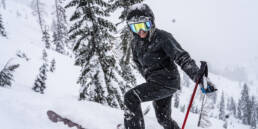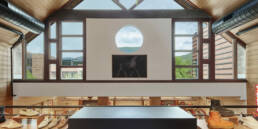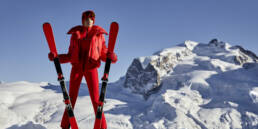Skiing Royalty – Of Racers and Rothchilds
An Ancient Alpine Village, A Big Name Banking Family, and Daring Downhill Racers – That’s France’s Fabulously Fashionable, and Famously Fast, Megève.
Story By Jay Cowan
I am blasting along the former racecourse of the notorious Émile Allais downhill, trailing former World Cup skier Adrien Duvillard Jr. The powder is pillowy, the run is fun, and my host rips. Combined with a dangerously good on-mountain lunch at L’Igloo, where the wild salmon and génépi liqueur-infused blinis had nearly undone me, it is a perfect introduction to Megève. Built upon ancient roots, wicked beauty, and big-time ski racing (plus deep snow and deeper Rothschild pockets), this stunning ski resort ranks as a favorite haunt for a gilded set that knows fun and quality when they buy it.
The town came to ski-world prominence thanks to Allais, a local racer who became France’s first world champion by sweeping the downhill, slalom, and combined races in 1937. By 1950 the run — now named after him — not only was part of the World Cup circuit, it was one of the most feared downhill courses in the world. In 1970, French star Michel Bozon died here in competition, and the run was removed from the circuit. But the event’s long tradition helped create a strong ski-racing aura here, helped by Allais’ presence and Duvillard’s own famously fast family.
“My father and his brother Henri both won on this course,” says Adrien fils, who has won a World Cup downhill himself. We’ve stopped to read one of several signs about the history of the off-piste run, which plunges through heavy forests and over sudden drops before finishing near the village. “Now this trail is just for fun,” he declares with a big grin. “But we still host regular World Cup events in Megève. It’s an important part of our heritage.”
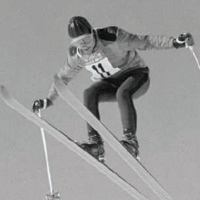
As is so often the case in the Alps, that heritage stretches back quite a bit — nearly a millennium — to a Catholic priory that stood where the town is now. By the time of the French Revolution, locals are fond of noting, the village held 2,400 people, most of them farmers or loggers. That history is preserved in the old core of Megève, still one of the most distinctively beautiful towns in the Alps.
It was this beauty that drew the Rothschilds, France’s renowned banking family, here shortly after World War I. Baroness Noémie de Rothschild, determined to create a French winter resort “to rival St. Moritz,” visited the area on the advice of her ski instructor, Trygve Smith, and was so charmed by what she saw that she had a chalet built here in 1920. It was joined several years later by a
larger hotel, now the Chalet du Mont d’Arbois,and Megève has been a favorite skiing destination of international high society ever since.
This artful collusion between racers and royalty has resulted in the modern Megève, full of fine art and architecture, fabulous food, chalets and clubs, and far-flung skiing. The latter is something locals are inclined to be defensive about because their neighbors in- clude Chamonix and Les Trois Vallées, and the slopes here plainly don’t go as big; few do. But the skiing is very good nonetheless.
Regardless, this alpine gem isn’t about Chamonix-style extremes. Making super-G sorties with Duvillard on wide-open, perfectly tilled swooshes through the woods and off the cascading mountainsides of Rochebrune, Alpette, and Cote 2000, the heart of the resort’s skiing reminds me of Snowmass, near my hometown of Aspen in Colorado. In both, the bread and butter is in the big boulevards that you can ski however you like, from street-racer speeds to full-family conga lines. And with ongoing efforts to lift-link the whole region, there are breadth and range here that rival those of the Alps’ superstars, with 125 lifts, multiple interconnected villages, and a very Snowmass-esque area of 3,000 acres.
I begin to wonder if Megève resembles Snowmass in another way: with a kind of terrain that might attract a younger, more hard- charging clientele to complement the existing very wealthy and mostly ski-centric crowd. The day after I ski with Duvillard, I decide to investigate. In half a meter of fresh on Mont d’Arbois I find requisitely gnarly, drop-filled lines in steep glades and under the lift lines of Bettex-Arbois. Only a handful of stoked local riders are in attendance. Happily, because “severe” isn’t part of the resort’s reputation, the wildest terrain gets very little traffic. That includes the heights of L’Epaule and the Mont Joly lift, which boast some seriously steep inbounds routes and the kind of cliffiy offi-piste that screams for a stop on a freeride tour. Towering behind these slopes ,close enough to taste, is the vaulted spine of the massive Mont Blanc range, giving everything a pumped-up, big-wow backdrop.
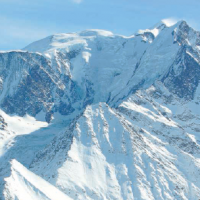
Megève also has much to recommend it après-ski. The village below has a flair and sporting elegance that remind me of Aspen, but with an 800-year head start. A cultural highlight of this antiquity is Megève’s Calvary path, a rare and rambling replica of the original in Jerusalem, built in the mid-1800s and once a famous pilgrimage site. Recently fully restored, it’s still very much worth a visit.
Walking along the snowy, cobbled, pedestrian-only streets with my wife on our first night in town, we are reminded more of Christmas than a spring evening in March. The church square is lit up like Rockefeller Center, the shops and clubs are bustling, and happy families are maneuvering through a fat-flaked storm as if encased in some oversize Savoyard snow globe.
Three- and four-story pastel stucco buildings line streets that bridge cascading streams. It all makes a fashionably tasteful set- ting for très chic names like Prada, Façonnable, and Hermès, along with scores of gift shops, boutiques, and celebrated restaurants. The legendary Club de Jazz Les 5 Rues, 3½ stories of gray-green stone that’s been packing in the crowds since World War II, is the flagship of the town’s noted club scene. We duck in out of the snow and quickly find ourselves fully immersed.
Wash-basin-size Grey Goose martinis are served with osetra caviar while a hot four-piece band plays in the cavelike recesses. The club is rich in character and characters, and we’re soon talking about art in Megève and Aspen with celebrated local sculptor Pierre Margara, who is staging a 40th-anniversary exhibition of “My Way” in the big Megève Sports Center. “Places like Megève and Aspen, art is very much a part of their identities,” he points out. “And thanks to the Rothschilds it has been that way here from early on.”
All over the resort and the surrounding mountains you can find a host of fashionable clubs, lodges, and chalets, and, this being France, a dizzying selection of restaurants. Of the 90-plus eateries here, almost half are situated in the mountains, and simply getting to some of them offers almost as much adventure as the skiing, as we discover while driving 15 minutes up a snowy serpentine slope in the dark to the beautiful hunting lodge-style L’Auberge de la Cote 2000, the Rothschilds.
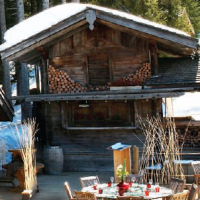
Some of the more relaxed dining finds are located outside the village proper. Five minutes north is La Demi Lune, owned by Suzy Duvillard, an American chef/artist who married into the Duvillards. She created all of the restaurant’s paintings and ceramics, along with its cuisine. Her eclectic menu showcases American favorites like chili and ribs along with traditional Savoyard fondues and plum dishes, and features artisanal cheeses, yogurts, breads and sausages, and locally grown produce. “Megève’s high level of gastronomy is very well known,” Suzy tells us. “More than two dozen restaurants are rated in Guide Michelin, Gault Millau, and others. Here at La Demi Lune, we are a little more down to earth and not so fancy.” Also scattered liberally around the valley are ultra-luxe ski chalets, a French Alps lodging concept pioneered and refined in Megève.
Created in the 1930s by architect Henry Jacques le Même (who would go on to design more than 200 of them), the chalets resemble cottages of the farms they replaced, or to which they still belong. Most are ski-in and at least as luxurious as the best hotels in town. The latter include the fabled Mont Blanc, which Jean Cocteau called “the 21st arrondissement of Paris,” and Megève’s very first chalet, Le Fer à Cheval,Y which has since been converted into a large hotel with one of the resort’s great kitchens.
Everywhere we go in Megève it glitters and hums, this high alpine kingdom where the racers and the Rothschilds continue their benevolent reign. And with nearby Mont Blanc and the French Alps for slopes and the Rothschilds as the village’s patron saints, it should continue so for another millennium.


